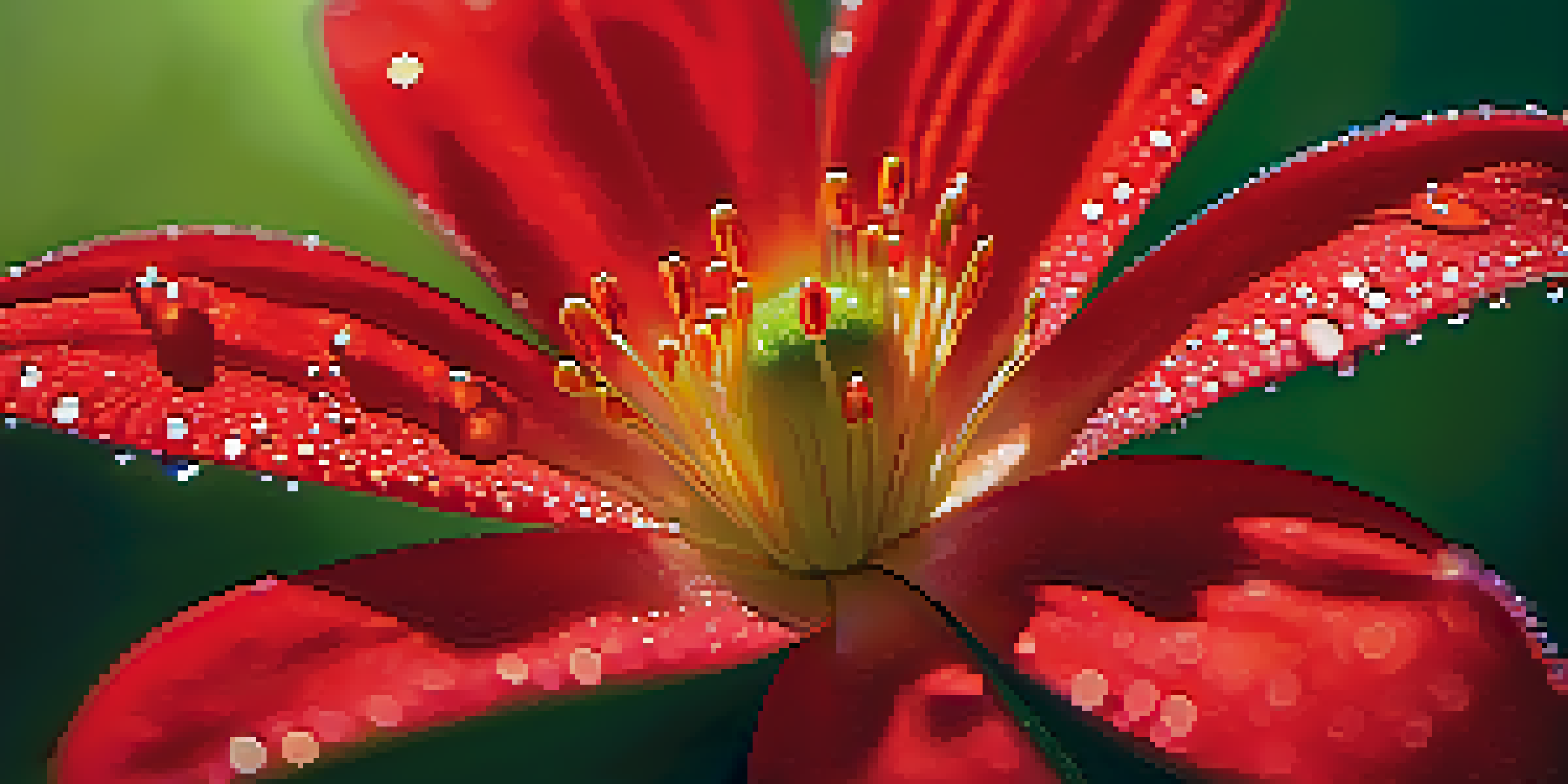Using Color Theory to Enhance Your Plant Photography

Understanding the Basics of Color Theory
Color theory is a set of principles that explains how colors interact, influence mood, and create visual harmony. At its core, it breaks down colors into three categories: primary, secondary, and tertiary. This framework helps photographers understand how to utilize colors effectively in their images, especially when capturing the vibrant hues of plants.
Color is the keyboard, the eyes are the harmonies, the soul is the piano with many strings.
For instance, primary colors—red, blue, and yellow—serve as the building blocks for creating other colors. By mixing these colors, you can create secondary colors like green, which is essential for plant photography. Recognizing these relationships allows you to create a balanced composition that draws the viewer's eye.
Ultimately, understanding color theory sets the stage for making informed decisions about your photography. By knowing how colors work together, you can enhance the visual appeal of your plant images and evoke specific emotions in the viewer.
The Role of Color Harmony in Photography
Color harmony refers to the pleasing arrangement of colors in a composition, creating a sense of balance and unity. When photographing plants, achieving harmony can significantly enhance the overall aesthetic of your images. For example, complementary colors, which are opposite each other on the color wheel, can create striking contrast, making your subject pop.

Imagine capturing a bright orange flower against a lush green background; the contrast not only highlights the flower but also creates a dynamic visual experience. By strategically placing colors in your frame, you can guide the viewer's eye and enhance their focus on the plant.
Color Theory Enhances Photography
Understanding color theory helps photographers create visually appealing images by effectively utilizing primary, secondary, and tertiary colors.
Experimenting with different color harmonies can lead to unique and captivating plant photographs. Whether you opt for analogous colors—those next to each other on the wheel—or go bold with complementary schemes, understanding color harmony is key to elevating your photography.
Using Color Schemes to Set the Mood
Colors can evoke specific emotions and set the mood of your photographs. For instance, warm colors like reds and yellows often convey energy and excitement, while cool colors like blues and greens can evoke calmness and serenity. When photographing plants, consider what mood you want your image to convey and choose your colors accordingly.
The colors are the smiles of nature.
A close-up shot of a vibrant red flower may evoke passion and intensity, while a tranquil scene of soft green leaves can instill a sense of peace. By intentionally selecting colors that align with your desired emotion, you can create a more impactful photograph.
Remember, the mood you set with your colors can enhance the story behind your plant photography. Whether it’s a lively garden scene or a serene forest, using color schemes thoughtfully can elevate your images to a whole new level.
The Impact of Natural Light on Color Perception
Natural light plays a crucial role in how colors are perceived in photographs. The time of day, weather conditions, and even the season can drastically affect the colors of plants and flowers. For example, the golden hour—just after sunrise or before sunset—creates warm, soft lighting that enhances the colors of your subjects.
When shooting in harsh midday light, colors can appear washed out or overly bright. Understanding how different lighting conditions impact color can help you choose the best time to capture your plant photography. Experimenting with various lighting scenarios can yield surprising results.
Natural Light Affects Color Perception
The quality and timing of natural light can drastically change how colors are perceived in plant photography, making it essential to choose optimal lighting conditions.
By taking advantage of natural light, you can create more vibrant and true-to-life colors in your images. This is especially important for plant photography, where the natural beauty of flora often shines brightest in optimal lighting conditions.
Incorporating Background Colors for Depth
The background of your photograph can significantly influence the perception of the main subject. A well-chosen background color can add depth and contrast, making your plant the focal point. For instance, a dark background can make bright flowers stand out, while a soft, blurred background can create a dreamy effect.
When choosing a background, think about the colors present in your plant. A light-colored flower may benefit from a darker backdrop to enhance its vibrancy. Conversely, if your plant has rich, dark hues, a lighter background can help it pop.
Don’t hesitate to experiment with different backgrounds, whether natural or artificial. By incorporating background colors thoughtfully, you can elevate the overall composition of your plant photography.
Experimenting with Color Filters in Photography
Color filters can be a powerful tool in plant photography, allowing you to manipulate the colors in your images creatively. By using filters, you can enhance certain hues, create mood, or even achieve a specific style. For example, a warming filter can add a golden tone, enriching the colors of your plants during a sunset shoot.
Filters can also help in achieving a more dramatic effect. A blue filter might cool down a warm scene, creating an ethereal look that enhances the tranquility of a lush garden. This experimentation can lead to unique outcomes that reflect your personal style.
Post-Processing Boosts Color Impact
Post-processing techniques allow photographers to enhance and correct colors in their images, ensuring that the vibrant beauty of plants is accurately represented.
While color filters are often associated with film photography, digital photographers can achieve similar effects using editing software. By exploring both methods, you can find new ways to express your vision through color in your plant photography.
Post-Processing Techniques for Color Enhancement
Post-processing is an essential step in modern photography that allows you to enhance colors and correct any imbalances. Software like Adobe Lightroom or Photoshop offers a plethora of tools to adjust saturation, contrast, and hue, making your plant images more vibrant and true to life. For instance, slightly boosting the saturation can make the greens of leaves more vivid without overwhelming the overall composition.
Additionally, you can use selective color adjustments to target specific hues within your image. If a flower’s color isn’t quite right, you can fine-tune it while keeping the rest of the image intact. This level of control helps ensure your plant photography reflects the beauty you witnessed in real life.

Don’t shy away from experimenting with post-processing techniques. The right adjustments can breathe new life into your photos, allowing the colors of your plants to truly shine and resonate with viewers.